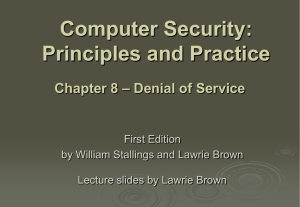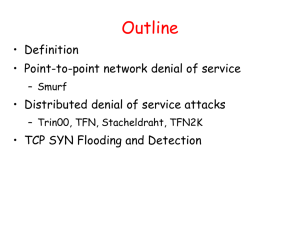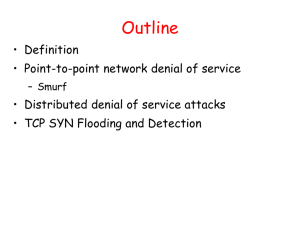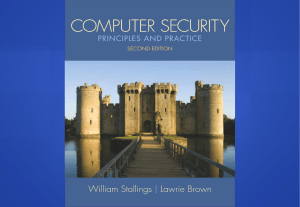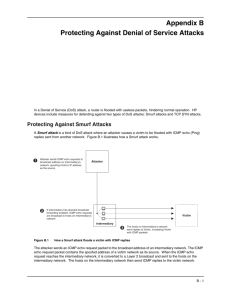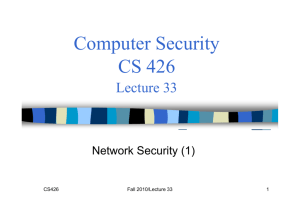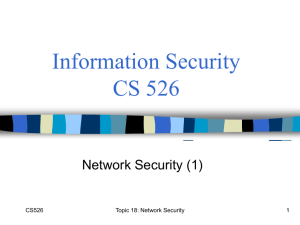Security+ Attacks Questions Answered
advertisement
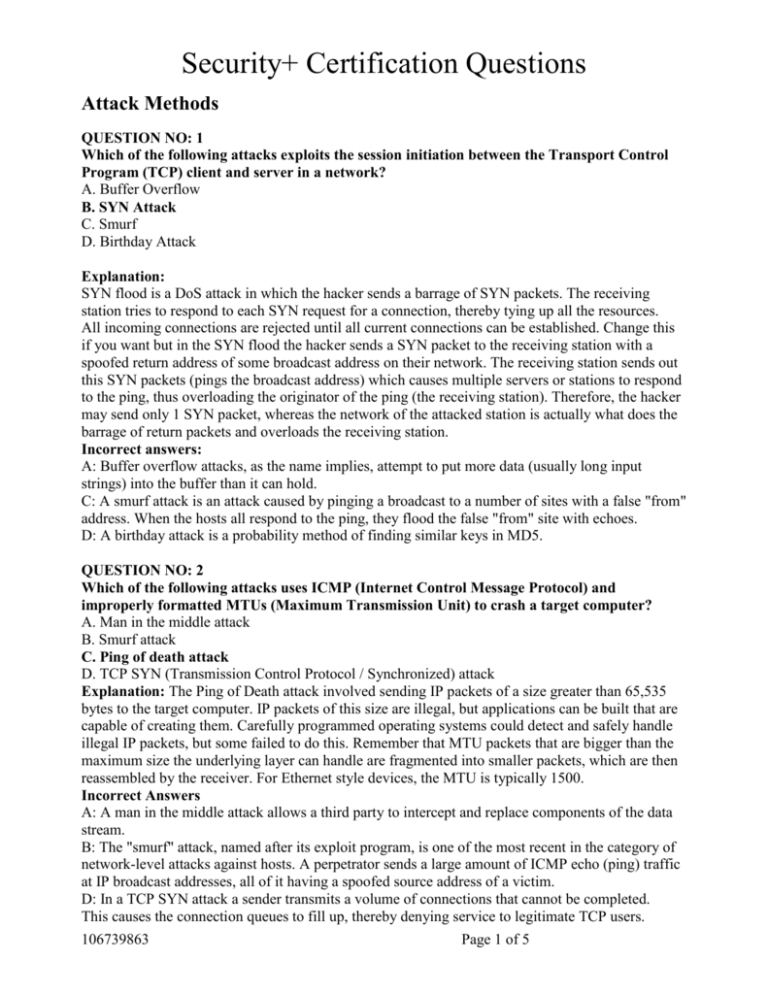
Security+ Certification Questions Attack Methods QUESTION NO: 1 Which of the following attacks exploits the session initiation between the Transport Control Program (TCP) client and server in a network? A. Buffer Overflow B. SYN Attack C. Smurf D. Birthday Attack Explanation: SYN flood is a DoS attack in which the hacker sends a barrage of SYN packets. The receiving station tries to respond to each SYN request for a connection, thereby tying up all the resources. All incoming connections are rejected until all current connections can be established. Change this if you want but in the SYN flood the hacker sends a SYN packet to the receiving station with a spoofed return address of some broadcast address on their network. The receiving station sends out this SYN packets (pings the broadcast address) which causes multiple servers or stations to respond to the ping, thus overloading the originator of the ping (the receiving station). Therefore, the hacker may send only 1 SYN packet, whereas the network of the attacked station is actually what does the barrage of return packets and overloads the receiving station. Incorrect answers: A: Buffer overflow attacks, as the name implies, attempt to put more data (usually long input strings) into the buffer than it can hold. C: A smurf attack is an attack caused by pinging a broadcast to a number of sites with a false "from" address. When the hosts all respond to the ping, they flood the false "from" site with echoes. D: A birthday attack is a probability method of finding similar keys in MD5. QUESTION NO: 2 Which of the following attacks uses ICMP (Internet Control Message Protocol) and improperly formatted MTUs (Maximum Transmission Unit) to crash a target computer? A. Man in the middle attack B. Smurf attack C. Ping of death attack D. TCP SYN (Transmission Control Protocol / Synchronized) attack Explanation: The Ping of Death attack involved sending IP packets of a size greater than 65,535 bytes to the target computer. IP packets of this size are illegal, but applications can be built that are capable of creating them. Carefully programmed operating systems could detect and safely handle illegal IP packets, but some failed to do this. Remember that MTU packets that are bigger than the maximum size the underlying layer can handle are fragmented into smaller packets, which are then reassembled by the receiver. For Ethernet style devices, the MTU is typically 1500. Incorrect Answers A: A man in the middle attack allows a third party to intercept and replace components of the data stream. B: The "smurf" attack, named after its exploit program, is one of the most recent in the category of network-level attacks against hosts. A perpetrator sends a large amount of ICMP echo (ping) traffic at IP broadcast addresses, all of it having a spoofed source address of a victim. D: In a TCP SYN attack a sender transmits a volume of connections that cannot be completed. This causes the connection queues to fill up, thereby denying service to legitimate TCP users. 106739863 Page 1 of 5 QUESTION NO: 3 Which of the following determines which operating system is installed on a system by analyzing its response to certain network traffic? A. OS (Operating System) scanning. B. Reverse engineering. C. Fingerprinting D. Host hijacking. QUESTION NO: 4 Which of the following network attacks misuses TCP's (Transmission Control Protocol) three way handshake to overload servers and deny access to legitimate users? A. Man in the middle. B. Smurf C. Teardrop D. SYN (Synchronize) QUESTION NO: 5 Which of the following is a DoS (Denial of Service) attack that exploits TCP's (Transmission Control Protocol) three-way handshake for new connections? A. SYN (Synchronize) flood. B. ping of death attack. C. land attack. D. buffer overflow attack. QUESTION NO: 6 What is usually the goal of TCP (transmission Control Protocol) session hijacking? A. Taking over a legitimate TCP (transmission Control Protocol) connection. B. Predicting the TCP (transmission Control Protocol) sequence number. C. Identifying the TCP (transmission Control Protocol) port for future exploitation. D. Identifying source addresses for malicious use. Explanation: The TCP/IP (Transmission Control Protocol/Internet Protocol) session state is altered in a way that intercepts legitimate packets and allows a third party host to insert acceptable packets. Thus hijacking the conversation, and continuing the conversation under the disguise of the legitimate party, and taking advantage of the trust bond. Incorrect answers: B: TCP sequence number attacks occur when an attacker takes control of one end of a TCP session. C: Port identification is not the aim of TCP session hijacking. D: Identifying source addresses is not the aim of TCP session hijacking. QUESTION NO: 7 In which of the following attacks does the attacker pretend to be a legitimate user? A. Aliasing B. Spoofing C. Flooding D. Redirecting 106739863 Page 2 of 5 QUESTION NO: 8 In an IP (Internet Protocol) spoofing attack, what field of an IP (Internet Protocol) packet does the attacker manipulate? A. The version field. B. The source address field. C. The source port field. D. The destination address field. QUESTION NO: 9 What is the process of forging an IP (Internet Protocol) address to impersonate another machine called? A. TCP/IP (Transmission Control Protocol/Internet Protocol) hijacking B. IP (Internet Protocol) spoofing C. man in the middle D. replay QUESTION NO: 10 You are the security administrator at TestKing.com. You detect intruders accessing your internal network. The source IP (Internet Protocol) addresses originate from trusted networks. What type of attack are you experiencing? A. social engineering B. TCP/IP (Transmission Control Protocol/Internet Protocol) hijacking C. smurfing D. spoofing Explanation: Spoofing is the process of trying to deceive, or to spoof, someone into believing that a source address is coming from somewhere else. Incorrect answers: A: Social engineering deals with the human aspect of gaining access and passwords. B: TCP/IP hijacking requires an existing session. C: Smurfing is a legitimate kind of DoS attack that does involve spoofing, however it doesn't match the above description. QUESTION NO: 11 Which type of attack can easily break a user's password if the user uses simple and meaningful things such as pet names for their passwords? A. Mickey Mouse attack C. Spoofing attack D. Random guess attack E. Man in the middle attack H. Replay attack I. Dictionary attack QUESTION NO: 12 In which of the following does someone use an application to capture and manipulate packets as they are passing through your network? A. DDos B. Back Door C. Spoofing D. Man in the Middle Explanation: 106739863 Page 3 of 5 The method used in these attacks places a piece of software between a server and the user. The software intercepts and then sends the information to the server. The server responds back to the software, thinking it is the legitimate client. The attacking software then sends this information on to the server, etc. The man in the middle software may be recording this information, altering it, or in some other way compromising the security of your system. Incorrect answers: A: This is a derivative of a DoS attack in which multiple hosts in multiple locations all focus on one target. B: A back door is an opening left in a program application (usually by the developer) that allows additional access to data. Typically, these are created for debugging purposes and aren't documented. Before the product ships, the back doors are closed; when they aren't closed, security loopholes exist. This is what gets to be exploited. C: A spoofing attack is an attempt by someone or something to masquerade as someone else. QUESTION NO: 13 What is an attack in which the attacker spoofs the source IP address in an ICMP ECHO broadcast packet so it seems to have originated at the victim's system, in order to flood it with REPLY packets called? A. SYN flood attack B. Smurf attack C. Ping of Dead Attack D. Denial of Service (DOS) Attack Explanation: A smurf attack uses IP spoofing and broadcasting to send a ping to a group of hosts in a network. Incorrect answers: A: A SYN flood attack is a common DoS attack that involves opening as many TCP sessions as possible. C: The ping of death crashes a system by sending Internet Control Message Protocol (ICMP) packets that are larger than the system can handle. D: DoS attacks prevents access to resources by users authorized to use those resources. QUESTION NO: 14 Which of the following attacks can be mitigated against by implementing the following ingress/egress traffic filtering? Any packet coming into the network must not have a source address of the internal network. Any packet coming into the network must have a destination address from the internal network. Any packet leaving the network must have a source address from the internal network. Any packet leaving the network must not have a destination address from the internal networks. Any packet coming into the network or leaving the network must not have a source or destination address of a private address or an address listed in RFC19lS reserved space. A. SYN (Synchronize) flooding B. spoofing C. DoS (Denial of Service) attacks D. dictionary attacks 106739863 Page 4 of 5 Explanation: By having strict addressing filters; an administrator prevents a spoofed address from gaining access. Incorrect answers: A: A SYN flood forces a victim system to use up one of its finite number of connections for each connection the initiator opens. C: Dos attacks can also be a result of SYN flooding. D: A dictionary attack cycles through known words in a dictionary file, testing the user's password to see whether a match is made. 106739863 Page 5 of 5
